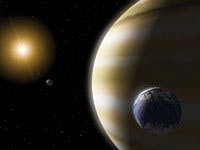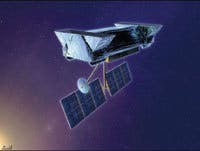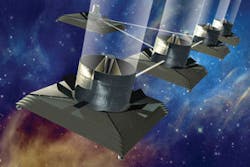OPTOELECTRONIC APPLICATIONS: ASTRONOMY: Optical instruments identify exoplanets
The search for planets outside our solar system—extrasolar planets or exoplanets, as they are known in astronomy circles—poses several unique imaging and instrumentation challenges. In addition to the sheer distances involved and what this means in terms of the time it takes for light to travel from these distant galaxies to Earth- or space-based observatories, astronomers must find ways to overcome the glare from the stars around which these exoplanets orbit. In addition, once an exoplanet is identified, researchers want to be able to determine various characteristics of its composition and behavior. All from, in most cases, hundreds of light years away.
Then, of course, there is the Earth’s atmosphere. Fortunately, the development of laser guide stars and adaptive optics has expanded the ability to look into space from Earth by helping astronomers account for atmospheric effects.
Size is another obstacle. The first exoplanets, detected in the mid-1990s from ground-based observatories that are able to measure the gravitational influences of a planet on a star, were about the size of Jupiter and primarily gas-based; more recently scientists have identified several exoplanets about the size of Neptune (17 times bigger than Earth). Finding smaller terrestrial masses will require moving the equipment into space via missions such as Kepler, Spitzer, the James Webb Space Telescope (JWST), the Space Interferometry Mission (SIM PlanetQuest), the Terrestrial Planet Finder (TPF), and Darwin (see Fig. 1).
“The fundamental problem with detecting planets around other stars is the high contrast between the intense radiation of the star and the visible light reflected by the planets or infrared light emitted by the planets,” said William Danchi, an astrophysicist at NASA Goddard Space Flight Center (Greenbelt, MD), whose research team is involved in many of these exoplanet projects. “The goal is to detect and then understand how the planets and their atmospheres are characterized.”
Optical detection techniques
Scientists have so far identified about 160 exoplanets, and it is estimated that as many as 30 billion Jupiter-size and 30 billion Earth-size exoplanets exist in the Milky Way galaxy alone.1 In addition to basic instrumentation such as telescopes and coronagraphs (a telescopic attachment that blocks out direct light from a star), astronomers use a number of optical methods to detect the presence of exoplanets.
Astrometry. Astrometry is the oldest method used in the search for extrasolar planets, dating back to the 1940s. Because exoplanets are most readily detected in relation to the stars they orbit, astronomers use astrometric techniques to detect exoplanets by measuring the displacement they cause in their parent star’s apparent position on the sky, due to their mutual orbit around the center of mass of the system. The SIM PlanetQuest mission, for example, will utilize astrometric techniques to detect terrestrial planets orbiting 200 of the nearest solar-type stars.
Radial velocity (Doppler spectroscopy). Radial velocity-also known as the Doppler method or wobble method-is generally acknowledged to be the most effective technique so far for detecting exoplanets. This approach measures variations in the relative velocity of the star with respect to Earth. Evidence for the existence of planets around nearby stars comes mostly in the form of Doppler shifts in the star’s spectra as one or more orbiting planets tug on the star; the spectrum is stabilized by observing the star through an iodine cell.
Photometry. Photometry-also known as photometric transit-detects distant planets by measuring the minute dimming of a star as an orbiting planet passes between it and the Earth. Photometry is one of the most sensitive methods for detecting extrasolar planets. The Kepler mission, due to launch in 2007, will use photometry to survey our area of the Milky Way to detect and characterize hundreds of Earth-size and larger planets. The 0.95-m-diameter Kepler photometer will simultaneously monitor the brightness of more than 100,000 stars for the life of the four-year mission.
Interferometry. Various forms of interferometry are used in ground- and space-based exoplanet research. One of the most popular methods is stellar interferometry; in its simplest form, this method involve two telescopes separated by some distance, such as the Keck Interferometer in Hawaii; a more complex version is the Very Large Telescope Interferometer in Chile, which uses four or more telescopes instead of two.
Another approach is nulling interferometry, where the composite signal from a star is minimized rather than maximized. It is similar to a coronagraph but uses multiple telescopes with a particular phase combination rather than a physical obstacle to block out unwanted signals, enabling a weaker nearby object, such as a planet, to emerge from what had been irrepressible glare. This technique will be used on the TPF and Darwin missions, among others.
Microlensing. Gravitational microlensing occurs when an object with enough mass (such as a planet) passes between Earth and a background star.2 If a planet and a star happen to pass in front of a background star, for example, the background star’s luminosity would appear to increase. This approach was used last year by the Optical Gravitational Lensing Experiment (OGLE) telescopes to discover a potentially rocky, icy body that may be the smallest planet yet found orbiting a star outside this solar system. Located more than 20,000 light years away in the constellation Sagittarius, planet OGLE-2005-BLG-390Lb is about five-and-a-half times the mass of Earth.
Space-based instruments
While ground-based telescopes can find young, low-mass stars and aid in the identification of their related planets, many astronomers believe the only way to truly detect and characterize Earth-size terrestrial planets is from space. Initial efforts in this direction have been demonstrated on the Hubble and Spitzer missions; in addition, the coronagraph and near-infrared spectrograph on the JWST will be used for exoplanet hunting as well as for studying galaxies and stars.
But the real planet-finder workhorses will not leave Earth for a few more years. Foremost among these missions are SIM PlanetQuest and TPF (and its European counterpart, Darwin). In an Earth-trailing solar orbit, SIM PlanetQuest, scheduled for 2015 or later, will use Michelson stellar interferometry with a resolving power astrometric accuracy of 4 µs (1000 times more powerful than comparable instruments) to search for Earth-size habitable planets around the closest 100 to 250 stars and study the distances and masses of stars farther away (see Fig. 2).The complexity of the mission’s design has been a challenge, said Bob Laskin, project technologist at NASA’s Jet Propulsion Laboratory (Pasadena, CA).“There are three interferometers on PlanetQuest and each has to control the lighting, phasing, and so forth,” he said. “So there is a challenge in terms of active control that needs to be done autonomously. Another challenge in stabilizing the system-to make the measurements the system must be very quiet, to about 10 nm. We also need to keep the measurement of the optics to about 10 pm; in fact, the metrology systems have probably been our biggest challenge.”
The TPF mission is twofold. TPF-C, expected to launch in 2014 in a halo (vs. Earth-trailing) orbit, is a single spacecraft comprising a moderate-size (4 × 6 m) visible-light telescope and coronagraph. The coronagraph would use a central disk and other techniques to blot out a star’s glare, allowing the instrument to detect planets that would otherwise be hard to spot.
“There have been breakthroughs in coronagraph technology in the last dozen years that suggest this is a good approach,” said Tony Hull, formerly with JPL and now director large optics and JWST program manager at Tinsley Optics (Richmond, CA), which fabricates aspheric mirrors for several NASA missions. “For example, to image a star you need a planet around a star and an optical system approaching λ/10,000. You can’t make a telescope directly that does this. But if you use corrective optics with equal and opposite corrective errors, you can bring it down to the order of λ/10,000, which reduces the scattered light.”
Not surprisingly, taking this technology into space poses a number of interesting design problems, according to Hull.
“Thermal management is very tricky in these systems, so you want to use materials such as carbon or graphite epoxy that have a near-zero expansion coefficient,” he said. “There are also gravitational issues. For example, you can build a stable corrector for the reimaging mirror like we did for Hubble, but the optical requirements were much less demanding than for TPF. With Hubble, wavefront retrieval was applied to determine what the aberrations were, and all of this was done in a zero-gravity environment. In a TPF-type mission you have to do a substantial amount of testing on Earth before the mission launches. And even then, there will be changes that occur once they go into space.”
The TPF-I mission, scheduled to launch by 2020, comprises individual spacecraft that fly in a constellation and beam IR light to one another to make detailed observations of stars and planets. Unlike Earth-based interferometers and SIM PlanetQuest, TPF-I is designed to be a fleet of 4-m telescopes that constantly shift to maintain the proper orientation with each other (see Fig. 3). Like the European Darwin project, set to launch around 2015 and also comprising a flotilla of space telescopes, TPF-I will utilize nulling interferometry.Given recent cutbacks in federal funding for space-based research projects, however, the future is uncertain for many of these missions. Some scientists have thus proposed “simpler,” less expensive instrumentation that could theoretically move into space more quickly, acting as a stepping-stone to missions such as TPF. Danchi’s group at NASA Goddard, for example, has developed the Fourier-Kelvin Stellar Inteferometer (FKSI), a passively cooled, space-borne instrument operating in the near- to mid-IR range (3 to 8 µm) that is designed for detection of extrasolar giant planets, characterization of their atmospheres, and observation of secular changes in their atmospheric spectra.
“The FKSI is a less complicated approach (than TPF) that is designed for a Discovery-class mission but uses two telescopes instead of four,” Danchi said. “We’ve identified 160 exoplanets but we don’t know anything about them. I’ve argued for years that we should start with something like the FKSI and then move on to TPF.”❏
REFERENCES
1. R.R. Britt, www.space.com (Jan. 29, 2002).
2. M. McKee, www.newscientist.com (Jan. 25, 2006).
Kathy Kincade | Contributing Editor
Kathy Kincade is the founding editor of BioOptics World and a veteran reporter on optical technologies for biomedicine. She also served as the editor-in-chief of DrBicuspid.com, a web portal for dental professionals.


